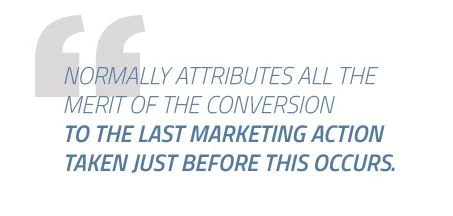When studying the data and main KPIs of a business, the most important thing is to make sense of the numbers and reach pertinent conclusions to be able to make the best decisions possible for the project. In Digital Channels it is like this, and just like the rest of the channels (retail, distribution, expansion, etc.), precautions need to be taken when interpreting the numbers so as not to give a false image or distort the real trend or performance on the web that is being analyzed.
One of the most common errors and one of the tasks that anyone responsible for the web analytics must do is make a comparison between the different attribution models. And that is, by default, what normally attributes all the merit of the conversion to the last marketing action taken just before this occurs. In many cases, it may be that this attribution model in which all the credit has been given to that achieved in the last action, is the correct one. However, you need to compare, go further, and see what has happened before the user ended up being converted.

AN EXAMPLE FOR UNDERSTANDING THE IMPORTANCE
Making a parallelism with the world of football, it is as if all the credit is given to the last player that scored or got the ball to the goal area, ignoring that there were players who had defended the area, had taken the ball, had strengthened the game play and had passed the ball so that all the player had to was drive it forward with the minimum of effort. Would it be fair to assign all the credit to the last player?
The same occurs in digital marketing. For example, just imagine that a user has seen a very attractive banner that your company has placed in important online media and has accessed the web for the first time through this channel. After a few days the same user accesses the site again after searching for opinions about your business and consulting social networks. Later, looking for your services in Google, they find your site and decide to buy from you. But not at this moment. Rather, they decide to return after a few days and to do this all they do is enter the name of your company in Google, access your web site by clicking on an advertisement or from paid hit results and then complete their purchase. Would it be fair to conclude that it has been the Paid Channel that has generated this conversion?
ATTRIBUTION MODELS
To lead this dilemma and obtain a more global vision different attribution models are used depending on the sector, the actions, your company in particular and many other factors that can vary in each case. This allows for more information in general about the return or the importance of each channel in the case that, instead of assigning all the value and invested resources to the last channel where the conversion took place, they are distributed over different implicated channels or, by contrast, it is decided to attribute all the merit to the first action that generates the first contact the user has with the brand. Each one of these scenarios is an attribution model and it is recommended use several of them and monitor the data depending on the results of each one.
You can personalize the different attribution models but we take as a reference those that come pre-configured in Google Analytics, without doubt, the most popular analytical tool on the Internet and provides us with a great deal of very important information. In which you can find the following attribution models:
[one_half]
- First Interaction Model Here, all the credit is assigned to the channel that creates the first contact between the client and the web site.
- Latest AdWords click model. With this option selected, you display the data and assign all the credit of the conversion to the last AdWords click.
- Impairment model over time. Here you assign the value of the conversion in a directly proportional way to the proximity in time relative to the web session that started the conversion.
- Linear Model. In this attribution model the credit for the sale is shared equally between all the channels involved in the purchase process of the user.
- Last Interaction Model This is the default option and, with it, you assign all the value of the conversion to the last channel that led the user to it.
- Position Dependent Model Here 40% of the value is assigned to the first and last channels that established the contract. The remaining 20% is shared amongst the intermediaries.
- Last Indirect Click Model In this case, all the credit of the conversion is given to the last channel through which the contact with the client was established before starting the last session on the web that ended up in conversion.
Once you have compared the different models, you will have a clearer picture of the real situation and performance of each one of the channels. In addition, this can also serve to adjust the marketing plan and understand how and when a channel functions better than another. Through this data you can discover, for example, that the e-mail channel works better strengthening the message of your company or the Pay channel is perfect for starting to connect with users interested in your products and services but not so effective in converting once they know your products and services.
CONCLUSIONS AND MAIN RISKS
After this brief overview, you have been able to get an idea of the importance of understanding and comparing the different attribution models. However, as a summary, we list those that, from our point of view, are the main risks that attribution models do not take into account

- Interpretation and extraction of conclusions about undetermined data that does not reflect the true situation of the business and the performance of each sales channel.
- Not knowing the real behavior of your clients and potential clients in your web page and the normal purchase flow of your products and services.
- Bad assignment and distribution of the investment (economic and time) between the different traffic acquisition channels of your business.
- Poor decision making and performing irrelevant and counterproductive against the interest of the company marketing actions.
Thankfully these situations can be avoided if you control the procedure of your accesses/leads as well as the user journey for making decisions. This type of information is important for identifying efficiency as well as defining budgets or for when assigning resources. Web analytics is extremely important to be able to make effective decisions.

















